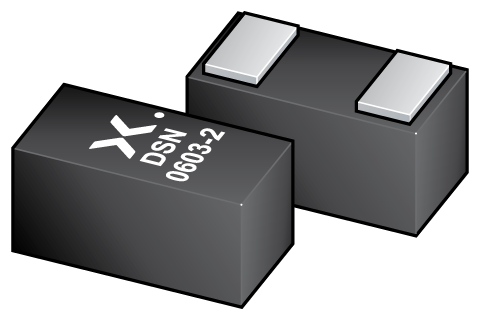Orderable parts
| Type number | Orderable part number | Ordering code (12NC) | Package | Buy from distributors |
|---|---|---|---|---|
| PESD3V3NW-SF | PESD3V3NW-SFYL | 934661346315 | SOD962-2 | Order product |
Discover Nexperia’s extensive portfolio of diodes, bipolar transistors, ESD protection devices, MOSFETs, GaN FETs, IGBTs, and analog & logic ICs. Our components power virtually every electronic design worldwide - from automotive and industrial to mobile and consumer applications.
Our products find applications across various industries, from automotive and industrial to power, computing, consumer, mobile, and wearables. With a commitment to innovation and sustainability, our components set benchmarks in efficiency, empowering our global customer base to develop energy-efficient and cutting-edge solutions.
Try out our devices and their performance with our comprehensive range of evaluation boards. Gain a deeper understanding of how our products can benefit your application, whether it's optimizing for efficiency, robustness, or reliability. You can find Application focus, Package focus, and different Nexperia Product focus boards here.

Register once, drag and drop ECAD models into your CAD tool and speed up your design.
Click here for more informationExtremely low capacitance bidirectional ESD protection
Extremely low capacitance bidirectional ElectroStatic Discharge (ESD) protection diode, part of the TrEOS protection family . The device is housed in a DSN0603-2 (SOD962-2) leadless ultra small Surface-Mounted Device (SMD) package designed to protect one signal line from the damage caused by ESD and other transients.
Bidirectional ESD protection of one line
Surge robustness IPPM = 20 A according to IEC 61000-4-5
Extremely low diode capacitance Cd = 1.2 pF max.
Extremely low clamping to protect sensitive I/Os
Extremely low-inductance protection path to ground
ESD protection up to ± 30 kV according to IEC 61000-4-2
Ultra small SMD package
Cellular handsets and accessories
Portable electronics
Communication systems
Computers and peripherals
| Type number | Package name | Nr of lines | Configuration | VRWM (V) (V) | Cd [typ] (pF) | VESD IEC61000-4-2 (kV) |
|---|---|---|---|---|---|---|
| PESD3V3NW-SF | DSN0603-2 | 1 | Bidirectional | 3.3 | 0.6 | 30 |
| Type number | Orderable part number, (Ordering code (12NC)) | Status | Marking | Package | Package information | Reflow-/Wave soldering | Packing |
|---|---|---|---|---|---|---|---|
| PESD3V3NW-SF | PESD3V3NW-SFYL (934661346315) |
Active | g |

DSN0603-2 (SOD962-2) |
SOD962-2 | SOD962-2_315 |
| Type number | Orderable part number | Chemical content | RoHS | RHF-indicator |
|---|---|---|---|---|
| PESD3V3NW-SF | PESD3V3NW-SFYL | PESD3V3NW-SF |
|
|
| File name | Title | Type | Date |
|---|---|---|---|
| PESD3V3NW-SF | Extremely low capacitance bidirectional ESD protection | Data sheet | 2021-03-03 |
| AN11046 | Recommendations for PCB assembly of DSN0603-2 | Application note | 2021-04-12 |
| AN90038 | ESD protection for high-speed interfaces without latch-up | Application note | 2023-07-11 |
| AN11046 | Recommendations for PCB assembly of DSN0603-2 | Application note | 2021-04-12 |
| AN90063 | Questions about package outline drawings | Application note | 2025-06-13 |
| Nexperia_document_brochure_ESD-Protection-Applications_022017 | ESD Protection Application guide | Brochure | 2018-12-21 |
| SOD962-2 | 3D model for products with SOD962-2 package | Design support | 2023-02-02 |
| Nexperia_package_poster | Nexperia package poster | Leaflet | 2020-05-15 |
| DSN0603-2_SOD962-2_mk | silicon, leadless ultra small package; 2 terminals; 0.4 mm pitch; 0.6 mm x 0.3 mm x 0.3 mm body | Marcom graphics | 2017-01-28 |
| SOD962-2 | silicon, leadless ultra small package; 2 terminals; 0.4 mm pitch; 0.6 mm x 0.3 mm x 0.3 mm body | Package information | 2021-01-06 |
| SOD962-2_315 | DSN0603-2 ; Reel pack for SMD, 7"; Q1/T1-Q2/T3 product orientation | Packing information | 2020-04-21 |
| PESD3V3NW-SF_Nexperia_Product_Reliability | PESD3V3NW-SF Nexperia Product Reliability | Quality document | 2025-05-30 |
If you are in need of design/technical support, let us know and fill in the answer form we'll get back to you shortly.
The Nexperia Longevity Program is aimed to provide our customers information from time to time about the expected time that our products can be ordered. The NLP is reviewed and updated regularly by our Executive Management Team. View our longevity program here.
| File name | Title | Type | Date |
|---|---|---|---|
| SOD962-2 | 3D model for products with SOD962-2 package | Design support | 2023-02-02 |
| Type number | Orderable part number | Ordering code (12NC) | Status | Packing | Packing Quantity | Buy online |
|---|---|---|---|---|---|---|
| PESD3V3NW-SF | PESD3V3NW-SFYL | 934661346315 | Active | SOD962-2_315 | 9,000 |
|
As a Nexperia customer you can order samples via our sales organization.
If you do not have a direct account with Nexperia our network of global and regional distributors is available and equipped to support you with Nexperia samples. Check out the list of official distributors.
The interactive datasheets are based on the Nexperia MOSFET precision electrothermal models. With our interactive datasheets you can simply specify your own conditions interactively. Start by changing the values of the conditions. You can do this by using the sliders in the condition fields. By dragging the sliders you will see how the MOSFET will perform at the new conditions set.